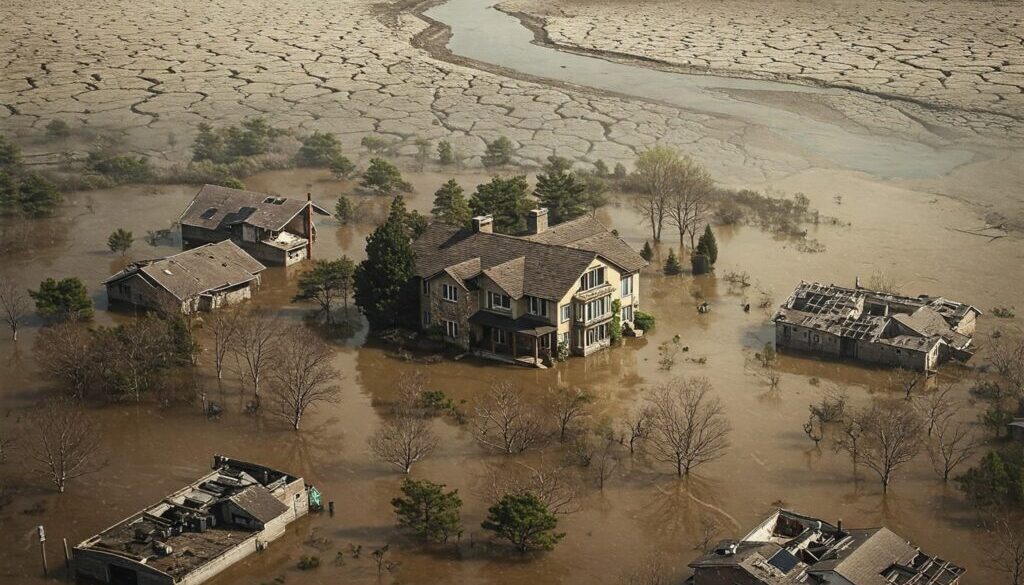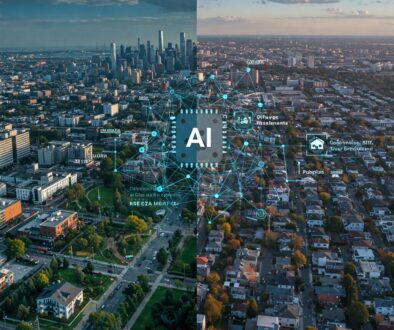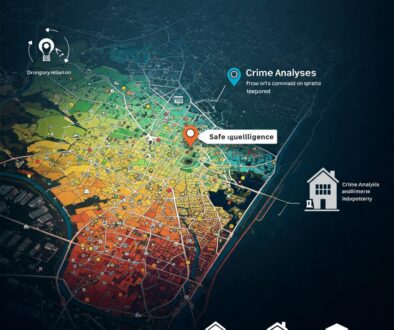How Climate Change Impacts Your Real Estate Investment Strategy
Climate change has moved from a theoretical future concern to a present-day reality for real estate investors. From coastal flooding to wildfire risk, extreme heat to changing precipitation patterns, the physical impacts of climate change are already affecting property values, insurance costs, maintenance expenses, and long-term viability across real estate portfolios.
In 2025, forward-thinking investors are leveraging AI-powered geospatial intelligence platforms like Locas.dev to incorporate sophisticated climate risk analysis into their investment strategies. This proactive approach not only helps mitigate risks but can also identify emerging opportunities in climate-resilient properties and locations.
The Multidimensional Impact of Climate Change on Real Estate
Climate change affects real estate investments across multiple dimensions:
1. Direct Physical Risks
- Flood vulnerability from sea level rise, increased precipitation, and storm surge
- Wildfire exposure in expanding high-risk zones
- Extreme heat impacts on building systems and outdoor usability
- Drought effects on water availability and landscaping
- Severe weather damage from increasing storm intensity
2. Operational and Maintenance Implications
- HVAC system stress and reduced lifespan
- Increased cooling costs in warming regions
- Water management challenges from changing precipitation patterns
- Landscape adaptation requirements for new climate conditions
- Building envelope performance under more extreme conditions
3. Insurance and Financing Shifts
- Premium increases in high-risk areas
- Coverage limitations for specific climate perils
- Insurance availability challenges in certain markets
- Lender requirements for climate risk mitigation
- Changing mortgage terms based on climate vulnerability
4. Regulatory and Compliance Evolution
- Building code updates addressing climate resilience
- Emissions and energy performance requirements
- Climate risk disclosure mandates
- Land use restrictions in vulnerable areas
- Resilience infrastructure assessments
5. Market Perception and Valuation
- Growing buyer awareness of climate risks
- Climate premium for resilient properties
- Discount factors for high-risk locations
- Changing desirability patterns across regions
- Accelerated obsolescence for properties unable to adapt
Key Climate Factors to Integrate Into Your Investment Strategy
Modern geospatial intelligence platforms analyze several critical climate-related factors that should inform your real estate investment decisions:
1. Flood Risk Evolution
Traditional Approach: Most investors rely on FEMA flood maps that are often outdated, binary (in/out of flood zone), and don’t account for climate change projections.
AI-Enhanced Approach: Advanced geospatial platforms provide more sophisticated analysis:
- Forward-looking flood modeling incorporating climate projections
- Probabilistic risk assessment beyond simple flood zone designations
- Multiple flood type analysis including riverine, coastal, and pluvial (rainfall) flooding
- Infrastructure vulnerability assessment for flood control systems
- Elevation and drainage pattern analysis at micro-topographical scale
Investment Strategy Implications: “We were evaluating a multifamily acquisition in Charlotte that showed minimal flood risk on FEMA maps,” explains Sarah Thompson of Meridian Investments. “Locas.dev’s analysis revealed the property had significant pluvial flood exposure due to local topography and projected precipitation increases. We negotiated a $1.2 million price reduction and invested $450,000 in water management improvements, creating both protection and a competitive advantage in the submarket.”
2. Heat Vulnerability Analysis
Traditional Approach: Investors typically consider only broad regional climate patterns without accounting for microclimate variations or future projections.
AI-Enhanced Approach: Modern platforms provide detailed heat exposure intelligence:
- Urban heat island intensity mapping at neighborhood scale
- Future temperature projection models based on climate scenarios
- Cooling infrastructure adequacy assessment
- Building heat performance analysis based on construction type
- Passive cooling opportunity identification
Investment Strategy Implications: In Phoenix, a commercial investor used heat vulnerability analysis to identify buildings with suboptimal thermal performance that could be cost-effectively upgraded with modern insulation and reflective roofing. The energy performance improvements not only reduced operating costs by 27% but also allowed them to achieve a 12% rent premium by marketing their buildings as “climate-optimized workspace.”
3. Drought and Water Stress Projection
Traditional Approach: Water availability is often considered a fixed regional characteristic rather than a dynamic factor vulnerable to climate change.
AI-Enhanced Approach: Sophisticated analysis reveals more nuanced water risk profiles:
- Water source vulnerability assessment for specific locations
- Regulatory change projection for water usage
- Landscaping adaptation requirement analysis
- Water efficiency improvement opportunity identification
- Alternative water source potential evaluation
Investment Strategy Implications: “We modified our development approach for a Las Vegas residential community based on water stress projections,” notes Carlos Rodriguez of Horizon Development. “By incorporating advanced water recycling systems and drought-resistant landscaping, we not only future-proofed against anticipated water restrictions but also created a marketing advantage that accelerated sales velocity by 22% compared to nearby conventional developments.”
4. Wildfire Exposure Modeling
Traditional Approach: Basic wildfire zone maps that don’t account for changing vegetation patterns, micro-climate factors, or climate change effects on fire behavior.
AI-Enhanced Approach: Advanced wildfire risk intelligence includes:
- Dynamic fuel load mapping based on vegetation and climate projections
- Wildfire spread modeling under various climate scenarios
- Defensive space adequacy assessment
- Structure vulnerability analysis based on building characteristics
- Evacuation route resilience evaluation
Investment Strategy Implications: An institutional investor in California used comprehensive wildfire exposure analysis to identify properties within the same general region that had dramatically different actual risk profiles based on topography, vegetation patterns, and building characteristics. This intelligence allowed them to acquire properties with significantly lower actual risk despite being in the same “wildfire zone” on traditional maps, resulting in both insurance advantages and value stability.
5. Climate Migration Impact Assessment
Traditional Approach: Population patterns are typically projected based on historical trends without accounting for climate-driven migration.
AI-Enhanced Approach: Forward-looking platforms analyze potential population shifts:
- Source region vulnerability assessment identifying likely outmigration areas
- Destination attractiveness modeling for climate migration
- Infrastructure capacity analysis for receiving regions
- Housing market impact projections in potential destination areas
- Economic shift analysis as industries adapt to climate realities
Investment Strategy Implications: “Our portfolio strategy now includes specific allocations to ‘climate receiver regions’ – areas that combine relative climate resilience with economic opportunity,” explains Jennifer Wu of Capital Partners. “Our investments in these regions have outperformed our broader portfolio by 16% over the past three years as early stages of climate-influenced migration begin to affect housing markets.”
Case Study: The River District Development
When Evergreen Development was evaluating a mixed-use development opportunity along a riverfront district, traditional analysis showed promising returns based on current market conditions and basic environmental assessment. However, Locas.dev’s comprehensive climate intelligence revealed a more complex picture:
Traditional Assessment:
- Outside current FEMA flood zone
- Strong market momentum in the district
- Good transportation accessibility
- Attractive waterfront location
- Standard construction approach planned
Climate Intelligence Enhanced Assessment:
- 37% probability of flooding by 2040 based on climate projections
- Significant heat island effect potential due to planned materials and design
- Water stress likely to impact landscaping viability
- Storm drainage capacity inadequate for projected precipitation intensity
- Energy performance vulnerable to predicted temperature increases
Rather than abandoning the project, Evergreen used this intelligence to modify their approach:
- Elevated critical infrastructure above projected flood levels
- Redesigned building orientation to maximize passive cooling
- Incorporated integrated water management systems
- Upgraded building envelope performance standards
- Implemented district-scale cooling solutions
The climate-adapted development required an additional $3.4 million investment (7.8% increase) but created multiple advantages:
- Insurance premium savings of approximately $175,000 annually
- Energy cost reduction of 32% compared to conventional design
- Marketing advantage as a “climate-smart community”
- Regulatory compliance future-proofing against anticipated requirements
- Financing advantages from lenders increasingly concerned about climate risk
The climate-intelligent approach is projected to increase the project’s IRR by 2.1 percentage points over its lifecycle due to these combined benefits.
Strategic Approaches to Climate Risk and Opportunity
Based on comprehensive climate intelligence, sophisticated investors are implementing several strategic approaches:
1. Climate Risk Segmentation
Rather than making broad regional decisions, segment properties based on specific climate risk profiles:
- High vulnerability / high adaptability – Target for acquisition and improvement
- High vulnerability / low adaptability – Consider for divestment or conversion
- Low vulnerability / unique advantages – Premium acquisition targets
- Moderate vulnerability / high mitigation potential – Value-add opportunities
2. Adaptation Investment Strategy
Identify specific climate adaptation improvements that offer the best returns:
- Heat mitigation measures – Often the most cost-effective interventions
- Water efficiency improvements – Increasingly valuable in many regions
- Flood resilience enhancements – Critical in vulnerable areas
- Energy independence solutions – Protection against grid vulnerability
- Structural reinforcement – For areas with increasing severe weather
3. Climate Opportunity Focus
Beyond risk mitigation, identify positive climate-related investment opportunities:
- “Climate haven” locations with favorable future conditions
- Renewable energy integration potential
- Resilient community developments
- Water-secure properties in at-risk regions
- Naturally cool locations in warming areas
4. Portfolio Climate Balancing
Create strategic diversification across different climate risk profiles:
- Balance exposure to different climate perils
- Diversify across climate-vulnerable and climate-resilient regions
- Include properties with different adaptation timeframes
- Combine cash-flow and appreciation strategies across climate profiles
- Match climate strategies to investment horizons
The Future of Climate Intelligence in Real Estate
As climate science and geospatial intelligence continue to evolve, several emerging capabilities promise even more sophisticated climate risk and opportunity assessment:
- Dynamic risk modeling that updates based on actual climate observations
- AI-optimized adaptation strategy recommendations
- Climate-smart development design automation
- Portfolio-wide climate risk optimization
- Integrated climate-financial scenario modeling
Conclusion: From Climate Risk to Strategic Advantage
Climate change presents both challenges and opportunities for real estate investors. Those who incorporate sophisticated climate intelligence into their strategies can:
- Mitigate physical risks to protect asset value
- Reduce operational vulnerabilities from changing conditions
- Create competitive advantages through climate-smart improvements
- Identify emerging opportunities in shifting markets
- Future-proof investments against regulatory and insurance changes
As climate impacts intensify, the gap between climate-intelligent investors and those relying on traditional approaches will likely widen. The most successful real estate investors of the coming decade will be those who transform climate awareness from a risk management exercise to a source of strategic advantage.
Ready to incorporate climate intelligence into your real estate investment strategy? Try Locas.dev today and discover how comprehensive climate analysis can transform your approach to property investment.
This article reflects the current understanding of climate impacts on real estate investment. For the latest updates and features, visit Locas.dev.
Keywords: climate change real estate, property climate risk, real estate climate strategy, geospatial climate analysis, real estate flood risk, climate adaptation investment, property climate resilience



